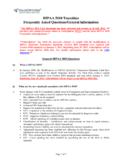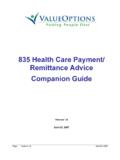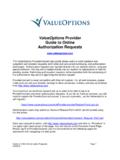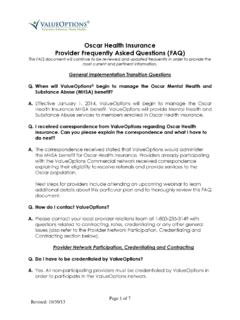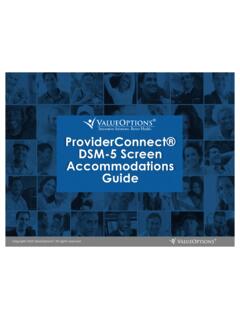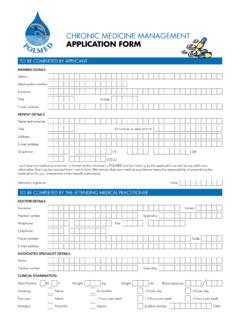Transcription of TREATING BIPOLAR DISORDER
1 Based on Practice Guideline for the Treatment of Patients With BIPOLAR DISORDER ,Second Edition, originally published in April BIPOLAR DISORDERA Quick Reference Guide1 Reviewed: 4/1/14-SRC 4/21/14-EMMCFor Continuing Medical Education credit for APA Practice guidelines ,visit order individual Practice guidelines or the 2002 Compendium of APA Practice guidelines , visit call : 4/1/14-SRC 4/21/14-EMMCTREATINGBIPOLAR DISORDER 3 Introduction TREATING Patients With BIPOLAR DISORDER : A Quick Reference Guide is asummary and synopsis of the American Psychiatric Association s PracticeGuideline for the Treatment of Patients With BIPOLAR DISORDER ,which wasoriginally published in The American Journal of Psychiatryin April 2002and is available through American Psychiatric Publishing, Inc.
2 The QuickReference Guide is not designed to stand on its own and should be usedin conjunction with the full text of the Practice Guideline. Algorithms illus-trating the treatment of BIPOLAR DISORDER are of IntentThe Practice guidelines and the Quick Reference Guides are not intend-ed to be construed or to serve as a standard of medical care. Standardsof medical care are determined on the basis of all clinical data availablefor an individual case and are subject to change as scientific knowledgeand technology advance and practice patterns evolve.
3 These parametersof practice should be considered guidelines only. Adherence to them willnot ensure a successful outcome in every case, nor should they be con-strued as including all proper methods of care or excluding other accept-able methods of care aimed at the same results. The ultimate judgmentregarding a particular clinical procedure or treatment plan must be madeby the psychiatrist in light of the clinical data presented by the patientand the diagnostic and treatment options development of the APA Practice guidelines and Quick ReferenceGuides has not been financially supported by any commercial : 4/1/14-SRC 4/21/14-EMMC TREATINGBIPOLAR DISORDER4B.
4 Treatment Options1. Acute Manic or Mixed Acute Rapid Cycling ..134. AdditionalInformation AboutPharmacotherapeuticAgents1. Lithium ..162. Divalproex/Valproate/Valproic Acid ..183. Carbamazepine ..204. Olanzapine ..225. PsychiatricManagement1. Perform a diagnostic Ensure the safety of the patient and others and determine a treatment setting ..63. Establish and maintain a therapeutic alliance ..74. Monitor the patient s psychiatric status ..75. Educate the patient and his or her Enhance treatment adherence.
5 87. Promote awareness of stressors and regularpatterns of activity and sleep ..98. Work with the patient to anticipate and address early signs of relapse ..99. Evaluate and manage functional impairments ..9 Reviewed: 4/1/14-SRC 4/21/14-EMMCTREATINGBIPOLAR DISORDER 5A. Psychiatric Management1. Perform a diagnostic for the presence of an alcohol or substance use DISORDER orother factors that may contribute to the disease process or complicateits treatment. Neurological conditions commonly associated with secondarymania are multiple sclerosis and lesions involving right-sidedsubcortical structures or cortical areas closely linked to the limbicsystem.
6 L-Dopa and corticosteroids are the most common medicationsassociated with secondary mania. Substance use may precipitate mood episodes. Patients may alsouse substances to ameliorate the symptoms of such about a history of time periods with mood dysregulation orlability accompanied by associated manic symptoms ( , decreasedsleep). BIPOLAR DISORDER commonly presents with depressive symptoms. Patients rarely volunteer information about manic or of Psychiatric Management Establish and maintain a therapeutic alliance.
7 Monitor the patient s psychiatric status. Provide education regarding BIPOLAR DISORDER . Enhance treatment adherence. Promote regular patterns of activity and sleep. Anticipate stressors. Identify new episodes early. Minimize functional : 4/1/14-SRC 4/21/14-EMMC TREATINGBIPOLAR DISORDER62. Ensure the safety of the patient and others and determine a treatment safety. Careful assessment of the patient s risk for suicide is critical; lifetimerates of completed suicide for people with BIPOLAR DISORDER are ashigh as 10% to 15%.
8 The overwhelming majority of suicide attempts are associated withdepressive episodes or depressive features during mixed episodes. Ask every patient about suicidal ideation, intention to act on theseideas, and extent of plans or preparation for suicide. Collect collateral information from family members or others. Assess for access to means of committing suicide ( ,medications, firearms) and the lethality of these means. Assess for factors associated with increased risk, such as agitation,pervasive insomnia, impulsiveness, or other psychiatric comorbiditysuch as substance abuse, psychosis (especially with commandhallucinations), or personality DISORDER .
9 Assess for family history of suicide and history of recent exposureto suicide. Consider the nature and potential lethality of any prior suicideattempts. Closely monitor patients who exhibit suicidal or violent ideas orintent. Carefully document your decision-making hospitalization for patients who pose a serious threat of harm to themselves or others, are severely ill and lack adequate social support outside a hospitalsetting or demonstrate significantly impaired judgment, have complicating psychiatric or general medical conditions, or have not responded adequately to outpatient.
10 4/1/14-SRC 4/21/14-EMMCTREATINGBIPOLAR DISORDER 7 Reevaluate the treatment setting on an ongoing basis to determinewhether it is optimal or whether the patient would benefit more froma different level of a calm and highly structured limiting access to cars, credit cards, bank accounts, ortelephones and cellular phones during the manic phase because ofthe risk of reckless Establish and maintain a therapeutic alliance. A therapeutic alliance is critical for understanding and managingthe individual patient.

